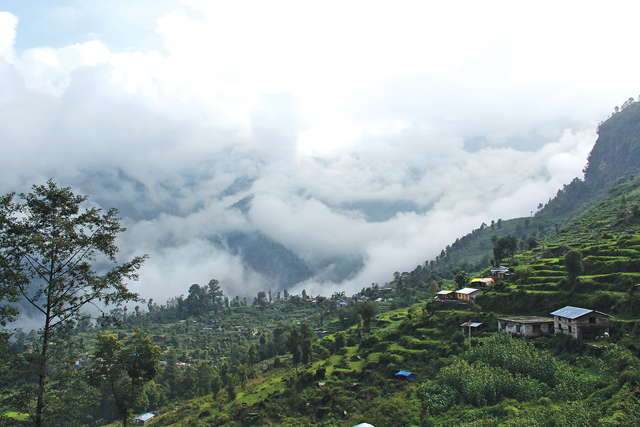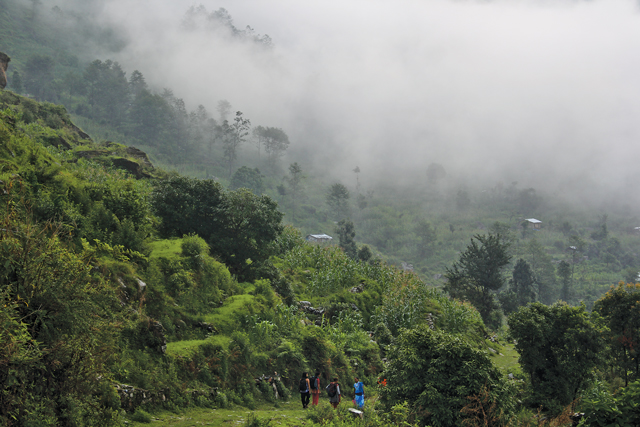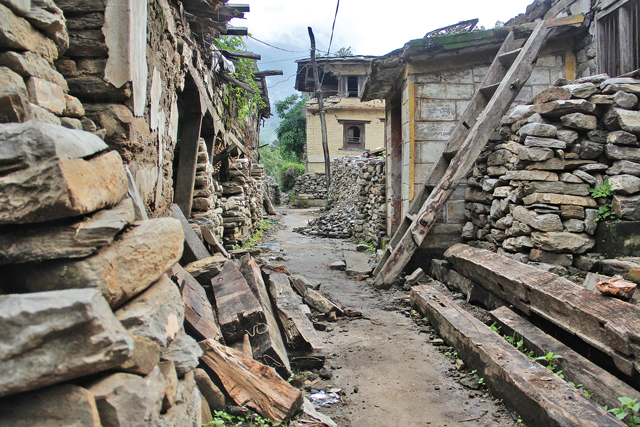Life is hard, but life in Sidhupalchok is beautiful.
 Sindhupalchok is a haven for the lungs, that is, heavenly for breathing. The day we arrive in the mountains, our coughing stops. That was actually no bronchitis or pneumonia, only “urbanitis” of our breathing apparatus! The mountains sing with trees taking in the sun, and in this season, being bathed afresh each night, glowing green and joyful each day. All sorts of wild birds give their unique speeches, and amazing flora and fauna survive in the mountain jungle of a place like Badegaun.
Sindhupalchok is a haven for the lungs, that is, heavenly for breathing. The day we arrive in the mountains, our coughing stops. That was actually no bronchitis or pneumonia, only “urbanitis” of our breathing apparatus! The mountains sing with trees taking in the sun, and in this season, being bathed afresh each night, glowing green and joyful each day. All sorts of wild birds give their unique speeches, and amazing flora and fauna survive in the mountain jungle of a place like Badegaun.
Living in our tents, we could hear deer calling each other at sundown, magnificent cicadas singing antiphonally in choruses across the valley at the height of day. There are cougars, and amusing monkeys still too shy to come pick off the bananas hanging on the tree outside—but not for long! There are also the white-faced gibbons the height of a 7-year-old child who swing over to have a cautious look, only to lope back in giant, elegant swings.
 From a certain angle, the rainy season can be seen as blessing time. The nightly downpour brings fresh water and bathes the parched verdure; the daylight sun comes through Himalayan breezes, bright and cool. But bus traffic is radically reduced, if not altogether cut off, on certain days, as most mountain roads become rivers by morning, and there are often little landslides and falling rocks requiring day-time repair. In general, during the five months of monsoon, mid-May to mid-October, all heavy outdoor construction work stops, and daily life becomes quieter, turning to arts and crafts or other activities under shelter.
From a certain angle, the rainy season can be seen as blessing time. The nightly downpour brings fresh water and bathes the parched verdure; the daylight sun comes through Himalayan breezes, bright and cool. But bus traffic is radically reduced, if not altogether cut off, on certain days, as most mountain roads become rivers by morning, and there are often little landslides and falling rocks requiring day-time repair. In general, during the five months of monsoon, mid-May to mid-October, all heavy outdoor construction work stops, and daily life becomes quieter, turning to arts and crafts or other activities under shelter.
In Nepal, high mountains rise in close proximity, so that for every kilometer, as the crow flies, from Kathmandu Valley towards the northwest mountainous region of Sindhupalchok, we must traverse hundreds of kilometers, going up and down on foot, or on wheels, over bumpy dusty mountain roads with dizzying hairpin turns and breathtaking views. Unlike the densely crowded houses of Kathmandu, here people spread out, and homes used to dot the terraced farmlands with bright colors. The devastating earthquake of 2015 destroyed everything, leaving virtually no home standing.

I was in Kathmandu at the time of the earthquake, having lunch with a sister in Boudha, when we felt the ground sway, and cups and dishes flew off tables. The garden wall behind us collapsed silently into a heap. We saw people fleeing into the narrow streets, shouting, looking for open spaces far from walls. We were urgently pushed out of the hotel, locked out without any of our baggage, left to seek refuge on our own.
For about 10 days, we took refuge in the nearby garden restaurant of the Tibetan Kunga Hotel Restaurant. Their kind waiter adopted me as his grandmother, and going to his room, carried out on his back his personal mattress and blanket for us to use in the garden. He looked after us three times a day, serving delicious vegetarian meals provided freely by the hotel owner, not only to his displaced lodgers, who were all sleeping outdoors in the garden now, but to all uninvited refugees like us two volunteers from Sindhupalchok, by chance stranded in Kathmandu. He refused to take a paisa from us, nor would he let us help doing the dishes. Such magnanimity, steadfastness, and good will in times of stress was amazing to see.
The giant Nepal Telecom NCell Tower of Kathmandu had collapsed in the temblor, and no calls could be placed to our base on the mountain, let alone to our various worried families overseas. For days on end, we sat cozily lost and isolated in the beautiful garden grounds, sharing stories when meeting English-speakers, and thinking how our families may worry without hearing a word from their loved ones in Nepal, perhaps under rubble.
Near the end of the second week, able to use a phone from a different company, we managed make contact and be picked up and brought back up to the mountain. It was a heartbreaking drive. Throughout the city, beloved monuments had suffered or collapsed entirely. All along the country roads we saw devastation. But, once we crossed the Indrawati River entering the district of Sindhupalchok, and started going up the winding roads, there was not a single house left standing. All the way, from the riverbed up the 2,000 meters to the top, there were only piles of stones, bricks, rubble wooden beams, and broken walls. Houses were split, or sunken into the ground, piled high with dirt and rubble above, covering traces of what had been. Adults sat on the piles, still dazed in shock, as children played in the debris smiling and laughing, freed from school. Not one rescue vehicle could be seen throughout the whole journey.
The tiny enclave of Todhkebari in Badegaun remained entirely unscathed in the midst of total devastation all around. Since August 2013, it had become the Dharma Centre of Maha Sambodhi Dharma Sangha the Maitri Guru, (see BBC Discovery Channel 2006 documentary The Boy with Divine Powers). It had been from here in Badegaun that Maitri teachings had begun spreading to the world afresh since 2013, “starting from zero.” And, it would be from here that the only succor for surviving villagers in the area would materialize. Unhurt in upstanding buildings, the young sanyasins and sanyasinis, as well as resident volunteers of various nations and ages, got together immediately with Nepali sangha members, who had driven up 10 tons of rice, all the way from the Terai in the southern plains. Together, they formed rescue units to visit nearby villages, distribute rice, and do what they could in the way of first-aid for the wounded. A month or so later, as proper aid had still not reached our outlying mountain communities, the Dharma Centre once more went out to help. This time, it was the Chinese Chan Temple community in Lumbini that joined in the rescue, donating 30 tons of good quality rice, as once more, sangha members from all over the country converged to drive up the mountain forming a convoy with the five lorries piled high with the rice in 30-kg family bags.

We drove through the night to avoid possible trouble along the way, accompanied by the militia through certain more populated zones, and arrived at the top of Badegaun well past midnight, exhausted, but exhilarated. By 08:30 next morning, volunteers now seasoned in rice distribution had set up desks and giant registers to record the names of each family coming to receive rice. This time, the sino-global team distributed rice to 2,000 families, feeding roughly
10,000 people.
Slowly and gradually over the past year, all around us, houses are rising, so far mostly in temporary structures covered with thin tin roofs. The consistent steady patience and friendliness of the thousands of earthquake victims is awe-inspiring. There is great strength and deep resilience in these simple mountain folks who accept each day with a kind of smile of recognition. Life is hard, but life in Sidhupalchok is beautiful.








